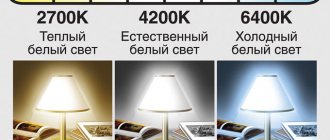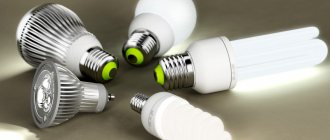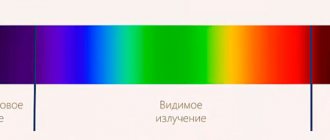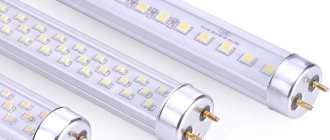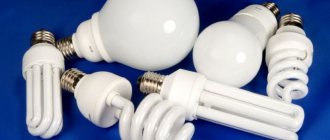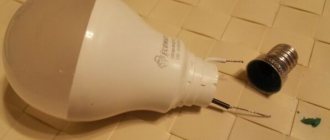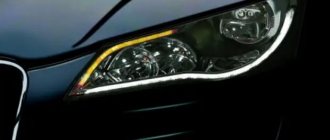The modern Russian lighting market is diverse. Manufacturers predetermine the optimal characteristics for each element at the design stage of lighting devices. Light sources (lamps) are no exception. Choosing the appropriate bulb shape, base type or lamp power for a particular lamp is not difficult. It is much more difficult for the consumer to decide on the type of light source: energy-saving or LED.
This issue can be resolved both by comparing the advantages of the common structural elements of energy-saving and LED lamps, and by determining the pros and cons of their additional operational parameters.
Design Features
The only structural element that unites all types of lamps is the base. Otherwise, the design differences between energy-saving devices and LED devices are significant.
All such devices are divided into three types:
- Incandescent. Base: tungsten filament; vacuum flask, usually containing an inert gas composition.
- Gas discharge.
- LED.
Only gas-discharge and LED light sources are considered energy-saving.
The glow of gas-discharge lamps is realized through an electric discharge in metal or gas vapor. Gas dischargers can be divided into:
- High pressure lamps. There are sodium, mercury and metal halide. This type is optimal for outdoor lighting.
- Low pressure lamps. This type includes fluorescent light sources. The main structural element is an electrode tube, which is filled with argon and mercury gas vapors. The inside is coated with phosphor. For it to glow, a short-term high-voltage discharge must hit the spiral. If there is low voltage in the electrical network at home, the lamps may light up problematically (not immediately and dimly or not light at all). They are used for both internal and external lighting of a house or apartment.
When you need to choose which light bulbs are better for your home: LED or energy-saving ones, the latter means fluorescent devices.
A modern alternative to the types of lamps described above are LED devices. Such lighting elements, due to their design, are characterized as:
- energy saving;
- environmentally friendly;
- durable, resistant to mains voltage surges.
A minor drawback is the cost of LED lamps. The technology for their production is new, not yet modernized, and therefore quite expensive. The return on one-time costs for their acquisition is almost 100%, due to their durability and cost-effectiveness.
Design features of LED sources:
- The principle of using light flux. The light emitter is an LED or a group of them. Such a diode element converts electric current into light by flowing current through a special crystal (semiconductor).
- The light-emitting element of the diode family converts electrical current into light by passing it through a semiconductor crystal. A significant advantage is that current is passed only in the required direction.
- The light emitter can be either in an open design or placed in a special flask.
Such light emitters are much more resistant to mechanical stress, in contrast to a similar element of fluorescent lamps (an electrode tube with mercury and gas vapor).
Differences in the design of CFL (compact fluorescent lamp) and LED light bulbs are one of the main parameters of technical and operational characteristics, allowing you to determine how they differ. Their cost-effectiveness is also important.
Safety and environmental friendliness
From this point of view, energy-saving lamps, unlike LED lamps, are not the best option:
- the flasks are made of glass, which is easily damaged not only during operation, but even during transportation;
- if damaged, mercury vapor inside the flask can lead to poisoning;
- Products require special disposal.
LED models, in turn, are durable and safe, which automatically gives them a serious advantage.
Luminous flux: which lamps are more economical
Most consumers are guided by this very criterion when choosing fluorescent or LED lamps. The difference in economics and electrical efficiency of these two types can be determined by comparing them in terms of energy consumption and operational efficiency with traditional incandescent lamps.
The most important indicator, without which it is impossible to make such a comparison, is the luminous flux. This parameter determines how light it will be in the room of the house or apartment. Measured in Lm (lumens; lm). The higher the luminous flux of a lamp, the brighter the room will be during its operation. Over time, this value may decrease.
Almost all manufacturers of energy-saving and LED light bulbs indicate on their packaging that the main operating parameters of their lamps correspond to the same characteristics of incandescent lamps.
Based on the average values of similar performance characteristics of most common lamp models and manufacturers, an analysis was made of the efficiency and economy of electricity consumption in relation to the luminous flux value. The results of such a comparison are shown in the table.
Based on the tabular data, you can easily determine that LED light bulbs are much more economical and have better quality of operation compared to similar energy-saving ones.
Main conclusions
Energy-saving lamps are LED and gas-discharge fluorescent products. To choose the right light bulb, you should study the characteristics of each of the presented types. Comparing devices, we can conclude that it is better to give preference to LED technology. The only drawback is the high cost, but given the rapid development of the LED industry, the price will only decrease.
Previous
Lamps and luminairesChoosing dimmable LED lamps
Next
Lamps and luminairesFeatures of parallel and serial connections of LEDs
Efficiency
The efficiency of the light bulb is also indicated by the ratio of the luminous flux to the operating power of the lighting element. This value isolates a certain set of indicators and is called efficiency (efficiency factor) or “luminous efficiency”. Measured in lm/W. The higher the indicator, the more economical the lamp operates.
For an incandescent lamp this value is very low - less than 10 lm/W, therefore, it has a very low luminous efficiency. This is its most significant drawback. For comparison: the average efficiency of an ice lamp is 90%; for most energy-saving ones it is below 90%.
To make it easier to make a choice, it is worth considering how else these types of lamps differ.
How to choose analogues
Choosing a suitable LED lamp instead of an energy-saving one is not difficult. To do this, it is necessary to select an analogue of lower power, which has approximately the same luminous flux. You can do it simpler - divide the power of the luminescent source by 2–2.5 and get the required power of the LED .
For example, when choosing LED lamps instead of 18W fluorescent lamps, you need to select products with a power rating from 7 to 9W. Such LEDs will create the same level of illumination. If you need LED lamps instead of 36 W fluorescent lamps, you need to choose products with a power consumption of 14 to 18 W.
Comparison of quality indicators of light sources
The fundamental differences in the main parameters of such characteristics should be summarized by highlighting the most basic criteria. Namely:
- Brightness. This parameter is also called luminous intensity. Measured in cd (cd). Information about this indicator is found on the packaging of lamps intended for non-home use. This is an important criterion when choosing an artificial source for the “running lights” of cars.
- Colorful temperature. Also called color rendering index, color temperature. It is measured in K (kelvins). The base is an indicator of the hue of the source color, which can be divided into:
- warm color. It is indicated on the packaging by numbers from 2700 K to 3300 K. This shade is comparable to the diffused color of the sky at sunset;
- daytime or natural color. Designated 4000 K; 4200 K. Compare with the shade of a dim sky;
- cold. The packaging indicates 5000 K.
To determine the priority in this choice, it is also worth considering the difference in the sizes and shapes of the lamps.
Colorful temperature
We perceive light from different types of light bulbs differently, feeling it as warm or cold. This impression is created due to the different emission spectrum of the lighting device. To distinguish lighting devices based on these characteristics, the concept of color temperature was introduced, which is measured in Kelvin (K). The higher this parameter, the more blue light rays in the emitted spectrum, and the colder the light is perceived. Among the options under consideration, it is LEDs that have the maximum color temperature, while energy-saving ones are closer to the comfortable characteristics of daylight.
Appearance: base type
The perception of interior design largely depends on the quality of lighting in the room. A correctly selected lighting option will highlight the advantages of the interior and hide the shortcomings. An important aspect, without which it will not be possible to implement such a design move, is the choice of a suitable shape and pleasant appearance of lamps for modern lighting fixtures.
Having decided on the type of light bulb, a person pays attention to the type of base. They are:
- Standard or screw. The most common in everyday life are E14 (minion) and E27. The number indicates the diameter of the base. There are no installation features provided. Light bulbs with sockets of type E40, E27 or E14 are allowed to be mounted in standard incandescent lamp sockets. The E27 base has a thread of 27 millimeters, and the E14 has a reduced thread of 14 millimeters.
- Pin. In everyday life they are not used as often as screw ones. Pin contacts are more often used in luminaires of modern lighting options. The marking of the cartridge is very important.
The number that follows the letter marking of this type of base is the distance between the pins, indicated in millimeters (GU4 or GU5.3, etc.).
After selecting the base, the type and size of the lighting electrical elements is selected. LED and halogen lamps have a more original shape (candle, ball) and beautiful design. Luminescent ones can only have the shape of a spiral or tube.
Types of energy-saving light bulbs for the home
Compact fluorescent light bulbs, abbreviated as CFLs, are called energy-efficient. The abbreviation will be used throughout the text.
By design, this is a conventional fluorescent light source in a more compact format. The power supply is installed at the base of the case near the plinth; for cooling, small holes are made through which air circulates.
- Main varieties:
- shape in the form of a spiral, circle, square, horseshoe;
- base E14, E27, E40;
- with a flask in the shape of a pear, candle, ball;
- Possibility of brightness control, dimming.
If you decide to switch from CFLs to LEDs, you will encounter a common problem. For LEDs with an E14 base, the luminous flux is no more than 600lm, due to the fact that the sizes are limited. The power in this case is 6-7W, this is almost analogous to a 60W incandescent.
LEDs may not be enough to illuminate a room where CFLs previously stood. The illumination will be lower than expected, but it should be with a margin, taking into account the degradation of LEDs. Even the Chinese don’t have powerful ones, although they write in parameters from 1000 to 1500 lm, which is 2-3 times too high.
Only recently E14 LEDs with 800-900 lumens, power consumption 10W, produced by X-Flash have appeared. But now they are in short supply, E14 at 10W are sold out immediately, they are not even often available on the manufacturer’s website.
- The main disadvantage of CFLs will be:
- slow ignition for up to 10 minutes;
- reduced light output at low temperatures.
How to choose energy-saving light bulbs
To choose the best energy-saving lamps you need to know 9 basic parameters, half are similar to diode ones.
- Main characteristics:
- rated power - energy consumption;
- power factor - the ratio of active and reactive;
- luminous flux – source brightness;
- color temperature – 2700K warm white or neutral white 4000K;
- color rendering index CRI – color rendering of objects;
- warm-up time - the period of time after which it shines by 60-80%;
- ignition time – time required for ignition;
- service life - the number of hours after which the brightness will drop by 30% of the initial value;
- number of switching cycles.
The easiest way to choose the best is by brand, it should be well-known. If you are hearing the brand name for the first time, it is better to refuse. The larger the brand, the more they worry about quality.
When you compare energy-saving ones in price with cheap diode ones, then in terms of service life they will not work much longer than CFLs. A good LED costs from 200 rubles.
Consider the installation location; if it’s on the street or in the entrance, there will be many people who want to steal it or break it. That’s why I put filament LEDs with a broken bulb in the entrance; they can’t be unscrewed without a tool. If you try to twist it by hand, you will break the LEDs, and it’s not very noticeable in the lampshade.
Comparison of shapes and sizes
For the modern consumer, it is important not only how economical the operation of one type of lamp will be compared to another, but also the priority of their appearance.
By choosing the optimal size, you can eliminate the situation when a lamp that is not suitable in size and shape sticks out of a regular lamp.
Energy-saving lighting elements can often be found in the form of a complex spiral tube with a phosphor deposited inside . They are as compact as possible - they can be mounted in a medium-sized lampshade.
LED devices have a much more varied interpretation of shapes and sizes. Of these, the two most common are:
- Mini size. The diameter of the crystal circumference is 1.5–3 cm. A source with this size of LED will turn out to be very small - less than three centimeters. Very often, such a light bulb is installed in furniture and suspended ceilings.
- Standard format. It all depends on the size of the flask. Its presence is not required. The diode does not require a specific environment. Bulbless LED lamps (called “corn” for their characteristic appearance) are increasingly being used.
As a result, when choosing which type of lighting sources is better, you can see that LED lamps have more advantages - many different shapes and sizes.
Other factors
An equally important indicator is the time the lamp is turned on. The luminescent source lights up at full power within a few seconds after power is applied. They do not like frequent switching, so it is better to install them in rooms where the lights are not turned on often. The LED light bulb has no such disadvantages and lights up instantly.
High humidity negatively affects the energy-saving source. Because of this, a film forms on the surface of the flask, interfering with stable operation.
The temperature range of LEDs is greater. They operate stably at almost any temperature.
Color rendering index is a parameter that shows how close the radiation from a source is to natural sunlight. The sun is the standard of the CRI index and is equal to 100 Ra. The LED index is 80-90 Ra, for fluorescent lamps the index is 60-90 Ra.
Which LED lamp to choose also depends on the shape - they are available in the form of a ball, candle and other shapes. The sizes are also different - there are both miniature products and standard format devices. Fluorescent lamps are produced only in the form of tubes and spirals.
LED sources have the ability to adjust brightness. For gas-discharge lamps, things are worse with this - it is difficult to find a sample to which you can connect a dimmer. Such a device will cost more, and not all functions will be fully performed.
LEDs and fluorescent lamps have a so-called “stray” glow. It appears for the following reasons:
- poor quality wiring;
- incorrect phase connection;
- with wire lengths of 10 meters or more;
- low-quality pulse sources;
- the presence of high-frequency powerful generators nearby.
Advantages of LEDs compared to fluorescent analogues
Of course, if you have the opportunity to choose, it is better to buy ice lamps to illuminate your home or apartment. To justify such a decision, it is enough to highlight the advantages of this type of light bulbs and compare them with an analogue, based on the above material, namely:
- Increased operational efficiency. The average luminous efficiency level in relation to operating power is 130–160 lm/W. For comparison: most energy-saving light bulbs have a maximum of 100 lm/W.
- Immunity to temperature. This means that this type of light source is capable of operating at different ambient temperatures, both at –60 °C and at +40 °C.
- The presence of different directions of light flux. An important advantage, especially when installing table or wall lighting devices. The ice bulbs mounted in them will provide a uniform luminous flux for a specific narrowly focused device.
- Quality of luminous flux. The design of this type of lamp is made with a different number of LEDs. Due to their significant concentration, the quality of light output will be as high as possible.
- Some modern devices with ice technology are designed with the ability to adjust the brightness level.
- Durability. The structural elements of ice light sources are impervious to most external factors and do not have burnout elements (as in old lamps - tungsten filament). The service life of an average energy-saving light bulb, according to manufacturers, is about 10,000 hours of operation, for an LED light bulb - from thirty to sixty thousand.
It all depends on the manufacturer, the price-quality ratio. Preference should be given to global brands: OSRAM; Philips or domestic - “Era”; "Space". These companies are stable in terms of selling high-quality products.
In addition to the technical and operational advantages of LED sources, it is also worth dwelling on a comparison of the impact on the user’s health.
The best energy saving
Among the TM energy-saving sources, the following are popular:
- Uniel ESL – produces a decorative look, shapes in the form of a candle or a pear. For indoor use and design. Designed for up to 10 thousand operating hours.
- Osram – compact fluorescent lamps. The best option for office lighting. The shape of the tube ensures uniform distribution of light over the entire area of the room. Frosted glass type. Service time up to 10 thousand hours.
- SPC – spiral shape. For standard base. A characteristic feature is resistance to low temperatures. The lighting is bright and evenly distributed. Frosted glass type. Energy savings up to 80%. Provides service time up to 8 thousand hours.
Effect on the human body: comparison of fluorescent and ice lamps
This criterion can most easily be determined by highlighting the following main points of impact:
- Radiation. LED light bulbs are completely coherent. This means that the LED itself acts as an emitter of light in the working spectrum. Compared to energy-saving ones, it does not have a noticeable effect on human vision. Fluorescent lamps are the opposite. The principle of producing light is based on the interaction of a discharge and a phosphor, which is exposed to ultraviolet radiation from the discharge. This creates lighting. Moreover, such a discharge also creates an additional luminous flux - ultraviolet radiation. The effect on vision is minor, but negative.
- Flicker. This performance characteristic is not typical for an ice lamp; there is practically no flickering, due to the fact that a constant voltage is required for the operating power of the LED. And the flickering frequency of fluorescent lamps is about fifty hertz.
- Mercury. Fluorescent lamps contain mercury vapor. If the flask breaks, the body is poisoned by certain doses of these fumes. LED sources do not contain any harmful substances.
Choosing an LED or energy-saving lamp to illuminate your home is a very pressing issue. It’s quite easy to decide by assessing the advantages and disadvantages of each type: both operational and structural. After such a comparison, the user will understand how to distinguish an ice lamp from an energy-saving lamp not only in appearance, but also to find differences in their functionality. Then you will be able to select the optimal light source for a specific lighting design solution and for the individual operational features of the room.
Temperature and service life
LED crystals are small, but emit a fairly intense luminous flux. In this case, part of the energy goes into heat. Its removal is carried out through aluminum radiators. If the product is handmade, this will significantly reduce its service life. The same effect is created by the lack of the required amount of thermal paste. Note that at low temperatures these features do not manifest themselves.
Fluorescent tubes are less resistant to frost. At temperatures closer to zero, they have to spend quite a lot of time reaching operating temperature. Without this, the device cannot reach the nominal brightness level. Under conditions of high humidity, a film forms on the fluorescent tube, reducing the surface resistance. This in turn affects the ignition voltage of the device.
At negative temperatures, neither ordinary fluorescent lamps nor CFLs work at all. On the contrary, LEDs benefit from cold, as they cool better.
In general, if you value durability, then replacing fluorescent lamps with LED lamps will be relevant for you. The service life of the latter ranges from fifty to one hundred thousand hours . Note that energy-saving light bulbs have a safety margin that is almost 5–10 times less.
Of course, when we talk about service life, we mean high-quality products from branded manufacturers that provide an appropriate guarantee. Cheap fakes from unknown manufacturers, both LED and fluorescent, will last a year or two at most.
Is it possible to control the brightness (dimming)
Dimming – controlling the brightness of a light source. LEDs allow you to change the brightness over a wide range. It is impossible to reduce the brightness of a gas-discharge lamp by reducing the voltage.
For these purposes, quite expensive high-frequency electronic ballasts are used. Changes in brightness are achieved by passing pulses with a frequency of about 50 kHz. With this mode of operation, the life of the device is significantly reduced.
Colorful temperature
According to these indicators, energy-saving and LED lamps are twins. Both have gradations of warm white, neutral white, cool white light.
Color rendering index
And again LEDs are better. An ordinary fluorescent lamp has a smaller emission spectrum than an LED. Only energy-saving lamps with a three-component phosphor, like LEDs, have an index of 80-90; in other models, the color rendering index is 60-80.
Bottom line: LED lights can freely adjust their brightness. Energy saving lamps - no. LED bulbs have the advantage.
Comparison of resistance to adverse factors
When used in rooms with high humidity or dust, the service life of energy-saving paws is significantly reduced. What is the difference between LED lamps and energy-saving ones?
LEDs are practically not afraid of contamination and mechanical cleaning of the surface. At the same time, the bulb of a gas-discharge lamp categorically does not accept touching. When installing a new energy-saving device, it is recommended to screw it into the cartridge without touching the glass bulb.
True, there is one interesting phenomenon: at very low temperatures, incandescent lamps show incomparably better results. I recommend checking out the experiment:

